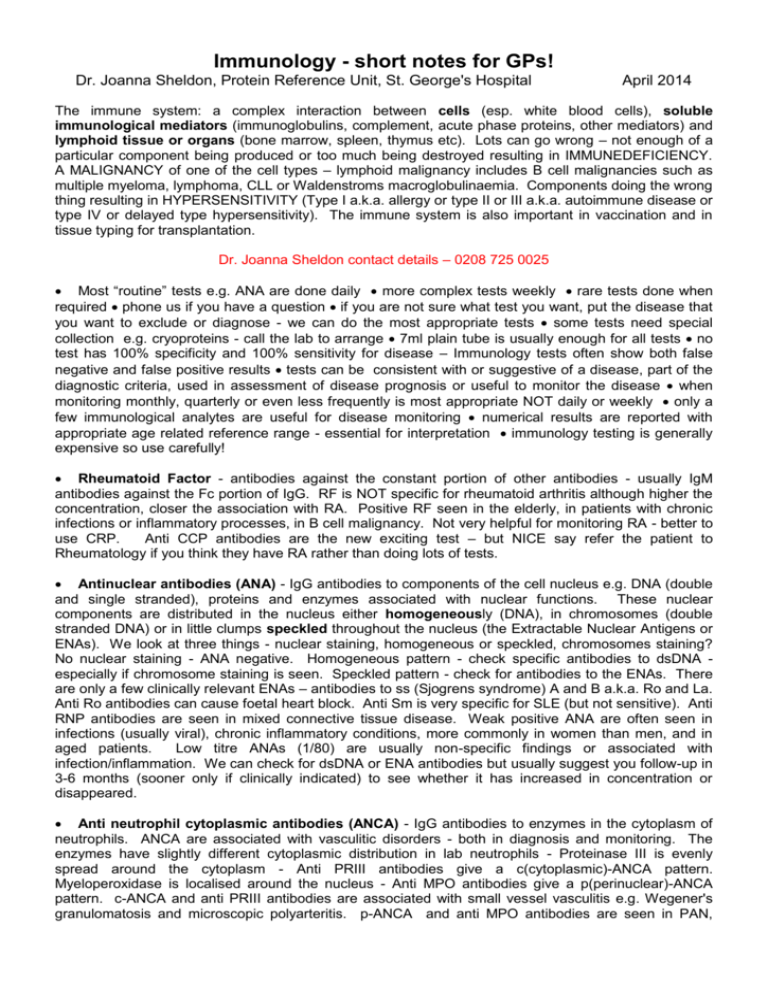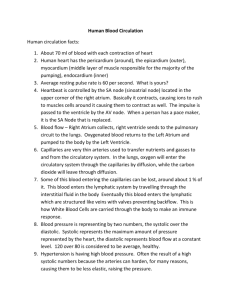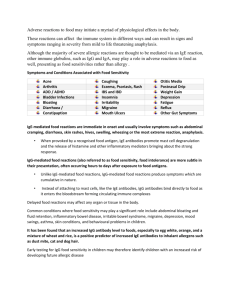Immunology - very short notes
advertisement

Immunology - short notes for GPs! Dr. Joanna Sheldon, Protein Reference Unit, St. George's Hospital April 2014 The immune system: a complex interaction between cells (esp. white blood cells), soluble immunological mediators (immunoglobulins, complement, acute phase proteins, other mediators) and lymphoid tissue or organs (bone marrow, spleen, thymus etc). Lots can go wrong – not enough of a particular component being produced or too much being destroyed resulting in IMMUNEDEFICIENCY. A MALIGNANCY of one of the cell types – lymphoid malignancy includes B cell malignancies such as multiple myeloma, lymphoma, CLL or Waldenstroms macroglobulinaemia. Components doing the wrong thing resulting in HYPERSENSITIVITY (Type I a.k.a. allergy or type II or III a.k.a. autoimmune disease or type IV or delayed type hypersensitivity). The immune system is also important in vaccination and in tissue typing for transplantation. Dr. Joanna Sheldon contact details – 0208 725 0025 Most “routine” tests e.g. ANA are done daily more complex tests weekly rare tests done when required phone us if you have a question if you are not sure what test you want, put the disease that you want to exclude or diagnose - we can do the most appropriate tests some tests need special collection e.g. cryoproteins - call the lab to arrange 7ml plain tube is usually enough for all tests no test has 100% specificity and 100% sensitivity for disease – Immunology tests often show both false negative and false positive results tests can be consistent with or suggestive of a disease, part of the diagnostic criteria, used in assessment of disease prognosis or useful to monitor the disease when monitoring monthly, quarterly or even less frequently is most appropriate NOT daily or weekly only a few immunological analytes are useful for disease monitoring numerical results are reported with appropriate age related reference range - essential for interpretation immunology testing is generally expensive so use carefully! Rheumatoid Factor - antibodies against the constant portion of other antibodies - usually IgM antibodies against the Fc portion of IgG. RF is NOT specific for rheumatoid arthritis although higher the concentration, closer the association with RA. Positive RF seen in the elderly, in patients with chronic infections or inflammatory processes, in B cell malignancy. Not very helpful for monitoring RA - better to use CRP. Anti CCP antibodies are the new exciting test – but NICE say refer the patient to Rheumatology if you think they have RA rather than doing lots of tests. Antinuclear antibodies (ANA) - IgG antibodies to components of the cell nucleus e.g. DNA (double and single stranded), proteins and enzymes associated with nuclear functions. These nuclear components are distributed in the nucleus either homogeneously (DNA), in chromosomes (double stranded DNA) or in little clumps speckled throughout the nucleus (the Extractable Nuclear Antigens or ENAs). We look at three things - nuclear staining, homogeneous or speckled, chromosomes staining? No nuclear staining - ANA negative. Homogeneous pattern - check specific antibodies to dsDNA especially if chromosome staining is seen. Speckled pattern - check for antibodies to the ENAs. There are only a few clinically relevant ENAs – antibodies to ss (Sjogrens syndrome) A and B a.k.a. Ro and La. Anti Ro antibodies can cause foetal heart block. Anti Sm is very specific for SLE (but not sensitive). Anti RNP antibodies are seen in mixed connective tissue disease. Weak positive ANA are often seen in infections (usually viral), chronic inflammatory conditions, more commonly in women than men, and in aged patients. Low titre ANAs (1/80) are usually non-specific findings or associated with infection/inflammation. We can check for dsDNA or ENA antibodies but usually suggest you follow-up in 3-6 months (sooner only if clinically indicated) to see whether it has increased in concentration or disappeared. Anti neutrophil cytoplasmic antibodies (ANCA) - IgG antibodies to enzymes in the cytoplasm of neutrophils. ANCA are associated with vasculitic disorders - both in diagnosis and monitoring. The enzymes have slightly different cytoplasmic distribution in lab neutrophils - Proteinase III is evenly spread around the cytoplasm - Anti PRIII antibodies give a c(cytoplasmic)-ANCA pattern. Myeloperoxidase is localised around the nucleus - Anti MPO antibodies give a p(perinuclear)-ANCA pattern. c-ANCA and anti PRIII antibodies are associated with small vessel vasculitis e.g. Wegener's granulomatosis and microscopic polyarteritis. p-ANCA and anti MPO antibodies are seen in PAN, Churg Strauss and rheumatoid vasculitis. There are other ANCA specificities but not in routine use. Serial monitoring of the anti PRIII or the anti MPO may be useful in monitoring. When investigating a patient with deteriorating or poor renal function, if you ask for an ANCA you should also consider anti Glomerular Basement Membrane antibodies (GBM) - they are associated with Goodpastures syndrome and patients may have very similar symptoms. ANCA and GBM antibodies would usually be requested for hospital in-patients or via Medical/renal admitting firms. Immunoglobulins and electrophoresis - Immunoglobulins behave as acute phase proteins and their concentration changes in numerous diseases; there are really only two clear indications for measuring Igs and doing electrophoresis 1. investigation of suspected immune deficiency and 2. investigation of suspected B cell malignancy. Consider Immune deficiency (ID) in any patient with repeated, severe, atypical infections. In adults, ID is most likely to be secondary to protein loss, malnutrition, cytotoxic treatment, immune suppression, infection, malignancy. Check IgG,A,M, albumin and protein EP. Primary ID is rare (IgA deficiency is the most common 1/700 of pop - many are asymptomatic) but there is a risk of developing IgA antibodies if given blood products and anaphylaxis on next exposure to IgA containing products. Common Variable ID worth considering in patients with bronchiectasis - IgG,A and M are usually all low and low-normal lymphocyte counts. IVIG is usually treatment and use IgG to monitor - patients with CVID have increased risk of autoimmune disease and malignancy. IgG has 4 subclasses and you can get isolated deficiencies of these - particularly IgG2 and IgG4 - measure if you have a normal IgG concentration but clinical suggestion of immune deficiency. Also consider complement components for recurrent meningitis - neisserial meningitidis infections are more common in patients with C6 deficiency - ask for CH50 - low in most complement deficiencies – generally specialist immunology requests. When considering lymphoid malignancy you should ALWAYS check SERUM AND URINE for paraprotein. Incidence of Ig classes in paraproteins is IgG>IgA>IgM>kappa>lambda>IgD>IgE. Kappa and lambda are the light chains and if MONOCLONAL are called Bence Jones protein. IgM paraproteins (big molecule, intravascular - can give hyperviscosity) usually result from tumours earlier in B cell progression - e.g. Waldenstroms macroglobulinaemia, CLL, lymphoma. Paraprotein types in myeloma: IgG>IgA>Bence Jones protein ( or are approx 20% of all myelomas) IgD (approx 3% of myelomas). BJP is small and passes easily through the glomerulus so you can miss BJ only myelomas if you only look in the serum - usually you see low serum IgG,A and M and a monoclonal band on the urine EP. BJ only and IgD myelomas are usually more aggressive. Diagnosis of myeloma - 2/3 of pp in serum and/or urine, lytic lesions on X-ray survey, abnormal numbers of plasma cells in BM. Paraproteins are also seen in benign disease, secondary to infection, in monoclonal gammopathy of unknown significance and with increasing prevalence in the elderly population. Small paraproteins can be incidental findings, particularly in the elderly - check concentration of paraprotein, presence of immune suppression, albumin concentration, presence of BJP in urine, renal function, 2microglobulin - powerful prognostic indicator in myeloma. Monitor paraprotein concentration, immune suppression, renal function, haematology. IgE and Allergy - an increasing problem. A good history is essential in identifying the possible allergens. Check what symptoms and when - pollen season, not winter - pollen allergy. Trees flower followed by grasses then weeds. Symptoms all year - house dust mite, feathers. For respiratory allergies, skin testing is the most appropriate investigation but you can do specific IgE. Skin testing must be done with resuscitation facilities available - it may be contraindicated if the patient has ever had a severe reaction. It can be difficult to skin test if the patient is a baby/child, if the patient has significant skin problems, it is unreliable if the patient is on anti-histamines and it lacks sensitivity for food allergies. Not all reactions are IgE mediated - e.g. strawberries, chocolate and wine can be direct pharmacologic effects. Most allergens have been reported to cause anaphylaxis - the most common are Penicillin, wasp and bee venom, peanuts, latex, egg, fish and shellfish. Other diseases where Immunology tests can be useful! - Coeliac disease - endomysial antibodies (also tissue transglutaminase) see NICE guidelines - Pernicious anaemia - intrinsic factor antibodies - Graves disease - TSH receptor antibodies - Hashimotos - thyroid peroxidase (or microsomal) antibodies – not helpful if TFTs are abnormal - Primary biliary cirrhosis - mitochondrial antibodies (and raised IgM) - Rheumatoid arthritis - rheumatoid factor (ANA may also be positive) see NICE guidelines - Bullous skin diseases - skin basement membrane or intercellular cement - Complement - renal disease in SLE or active immune complex disease





